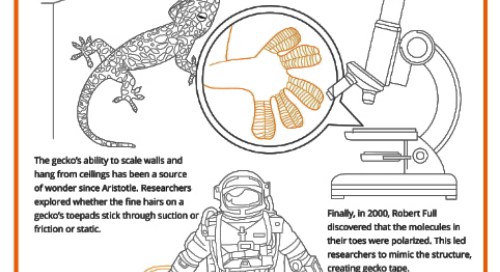the-ethics-of-science-and-health-journalism-a-q-a-with-gary-schwitzer
June 08, 2017
Science and health journalists face pressures to publish more and to publish quickly, which can sometimes be at odds with the need to communicate information with the right context. To explore some of the ethical questions pressing on this community, we chatted with Gary Schwitzer, publisher and founder of HealthNewsReview.org
Q. You and your team are responsible for HealthNewsReview.org. How did this project begin, and why?
A. In 44 years in health care journalism, I’ve seen countless repetitions of the same flaws in health care reporting. I was always looking for a more comprehensive, analytic way of critiquing and pointing to possible improvements. Around 2004 I learned of a website named MediaDoctor.org that had begun to systematically review Australian news coverage of health care interventions. That project applied 10 standardized criteria that the team felt were vital in health care news. I thought it was a terrific advance and soon got the project leader’s permission to adopt their approach to a new site I launched in the US in 2006.
However, HealthNewsReview.org has always been much more than a media watchdog project. In my mind, it’s a rubber-meets-the-road health care reform initiative. We will never effect truly meaningful health care reform if we don’t improve the public dialogue about health care. So it’s our goal to help people improve their critical thinking about claims made about treatments, tests, products and procedures – to help people learn a few concepts so that they could understand how to evaluate claims about health care research.
Q. Can you talk about some of the challenges faced by health care and science journalists?
A. As we speak,I’m reading about journalism industry cutbacks and staff buyouts even at the New York Times. In many traditional newsrooms, the health/medical/science news beats have taken a beating. Fewer people are expected to do more with less – and to do it in multiple formats. The expectation is that the digital side of any news operation must be served, is often served first and with more emphasis.
It’s a particular challenge when news managers treat health care and science news like any other beat. Troublesome story formulas often look like this: follow a PR news release, interview an expert quoted in the news release, get a patient interview (often provided by the PR folks promoting the story idea), and get it up on the web ASAP. On health care stories, much more is needed, and that’s why we apply our 10 systematic story review criteria. Here are those criteria, and the percentage of unsatisfactory scores for the 2,400 stories reviewed in the past 11 years.
Did the story:

In our minds, even 8% of 2,400 stories is too much. We also now review PR news releases, but with a slightly revised set of criteria. The grades for the news release are worse – across the board – than those reported above for news stories.
Q. What are the consequences of inaccurate or misreported health and science research?
A. When health care news is reported in an inaccurate, imbalanced or incomplete manner, people will predictably be hurt. The harms may include:
- Being misled into placing false hope in an unproven approach.
- Scheduling unnecessary physician visits because of something seen or heard in the news, only to have it debunked – a waste of time for all involved.
- Spending time and money pursuing ideas that have no relevance in an individual’s life while failing to pursue more evidence-based approaches.
More broadly, confused or frustrated news consumers or health care consumers may lose trust in medicine and science. And journalism’s integrity and trustworthiness may be harmed.
It’s important to emphasize that some individual journalists and some news organizations still apply a great deal of rigor in health/medical/science news reporting – perhaps better than we’ve ever seen. But the valleys in between those occasional peaks of excellence are becoming wider and deeper, perhaps overcoming the good that is done with solid reporting.
Q. What actions can the research community take to support more accurate coverage of evidence and results?
A. When I published our early results in PLoS Medicine in 2008, the journal’s editors published an accompanying editorial in which they stated:
“Schwitzer's alarming report card of the trouble with medical news stories is thus a wake-up call for all of us involved in disseminating health research—researchers, academic institutions, journal editors, reporters, and media organizations—to work collaboratively to improve the standards of health reporting.”
Researchers and their institutions could help ensure that research publications follow criteria similar to our news story review criteria. In a nutshell, they should be true to the science and avoid marketing hype.
Journal editors and peer reviewers should ensure that the limitations of research findings are explained thoroughly. They can insist that manuscripts are not allowed to use so-called mismatched framing, wherein potential benefits are framed in the most positive light and potential harms are minimized. Journal policies on conflict of interest disclosure should be regularly scrutinized and communicated to keep up with a constantly changing COI landscape. Journal editors know that many patients now access manuscripts online or through patient support groups. It is no longer an environment in which journals are forums for private conversations among scientists.
Those who write PR news releases for researchers’ institutions and/or by medical journals should reflect on our news release review criteria and think carefully about the impact of their PR efforts on journalists and on the general public. We are concerned enough about the impact of news releases that we have now begun offering pre-publication assistance to PR professionals who send us drafts.
These are just a few of the steps that could be taken. But this question deserves a much deeper discussion. Fortunately, more concerned individuals and institutions are starting to tackle some of these problems.
Q. Recently, the role of the news media has been under scrutiny. What do you think the media’s role should be in today’s world, specifically health and science journalism?
A. The old saw still applies – that it is the job of journalism (in this case, health/medical/science journalism) to comfort the afflicted and afflict the comfortable, and to give voice to the voiceless.
Our 11-year data-rich experience shows that the majority of news stories by major news media that we have reviewed fail to adequately address costs, benefits and harms, the quality of evidence and alternative options. To the extent that such stories influence health care consumers, it is often a bad influence. The afflicted, the voiceless, are not helped.
On the other hand, some individual journalists and organizations have met the challenge of going deeper on complex health care issues. Journalism that employs deep data dives, investigations, analysis, context and background in covering health/medical/science news is a bright spot in the current environment.
As Americans devote a greater percentage of the GDP to health care than any other country on earth-sometimes without a return on that investment-other journalists must take some portion of the responsibility for promoting expensive, unproven ideas for which, once all of the evidence is in, we may well find that the harms outweigh the benefits.
If news organizations can’t or won’t devote the resources required to cover health care news in depth, they’d be better off covering sports or fashion and leaving health care news to others. As the humorist Henry Wheeler Shaw wrote:
“The trouble with people is not that they don’t know, but that they know so much that ain’t so...I honestly think it is better to know nothing than to know what ain’t so.”
Gary Schwitzer has specialized in health care journalism for 44 years. He has published the HealthNewsReview.org site for 11 years. In 2014, JAMA Internal Medicine published a summary of the project, “A Guide to Reading Health Care News Stories.” In 2017, The BMJ published his editorial, “The pollution of health news: Time to drain the swamp.” Gary worked in television news for 15 years – in Milwaukee, Dallas and CNN. He was founding editor-in-chief of MayoClinic.com. The Kaiser Family Foundation published his 2009 report, “The State of U.S. Health Journalism.” For the Association of Health Care Journalists, he wrote the organization’s Statement of Principles, and a guide for members on how to report on studies. He taught health journalism and media ethics at the University of Minnesota for 9 years and now has an Adjunct Associate Professor appointment in the UMN School of Public Health. The American Medical Writers Association honored Schwitzer with one of the organization’s highest honors, the McGovern Award for preeminent contributions to medical communication.
Image Credit: Luinenberg Photography







